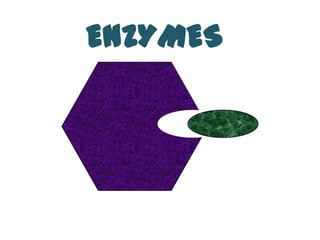
Enzymes
- 1. ENZYMES
- 2. What are ‘enzymes’? enzymes are protein in nature and act as catalysts
- 3. Catalysts are chemical substances which speed up metabolism (chemical reactions inside cells)
- 4. Enzymes are needed e.g. for digestion Examples of enzymes: Lipase Maltase Sucrase Lactase Amylase
- 5. Naming Enzymes A short name ending in : Lipase Maltase Sucrase Lactase Amylase Except exist: Pepsin Trypsin
- 6. Enzymes : Exert their Produced function both inside cells inside & outside the cell
- 7. Extracellular Intracellular enzymes enzymes act outside a cell act inside a cell Respiration
- 9. Lock and Key theory explains how enzymes work
- 10. Lock and Key theory Bond formation Bond breaking
- 11. Question: MAY, 2008 a) What is an enzyme? (2) An enzyme is a protein which speeds up a chemical reaction i.e. a biological catalyst.
- 12. b) Explain, using diagrams, why an enzyme acts on just one particular substrate. (3) Enzymes have a specific site known as the active site. The active site has a specific ‘shape’ to which only a specific substrate will fit. When different substrates collide with an enzyme, only the substrate with a complementary shape will fit the enzyme. (Lock and Key hypothesis)
- 13. Properties of enzymes 1. Enzymes are always proteins 2. Enzymes are specific in their action 3. Enzymes can be used all over again
- 14. Properties of enzymes 4. Enzymes are destroyed (denatured) by heat Protein in egg white is denatured by cooking.
- 15. Substrate CANNOT fit in active site Enzyme + Enzyme substrate denatured by heat or extreme pH Denatured enzyme cannot combine with substrate
- 16. Wrong to say ‘enzyme is killed’
- 17. Fig. 2 Graph to show the effect of temperature on the rate of reaction. Enzyme becomes denatured above the optimum temperature.
- 18. Temperature Affects Enzyme Action: Little activity at low temperature Rate increases with temperature Most active at optimum temperatures (usually 37°C in humans) Activity lost with denaturation at high temperatures 18
- 19. Properties of enzymes 5. Enzymes are sensitive to pH enzymes are denatured by extremes of pH Rate of reaction pH
- 20. Fig. 3 Graph to show the effect of pH on the rate of four different enzymes. What is the optimum pH of pepsin?
- 21. ONE use of enzymes Enzymes are obtained from bacteria and are used to make biological detergents.
- 22. Question: [SEP, 2010] a) Explain why biological detergents can only be effective when used in low temperatures. (2) Enzymes are proteins whose shape is affected by temperature. Above their optimum temperature, enzymes become denatured. The substrate does not fit in active site.
- 23. Question: [SEP, 2010] b) Give TWO environmental advantages associated with the use of biological washing powders. (4) 1) No harm is done to the environment as they are natural products. 2) As they work at low temperatures, there is no need to heat the water. Thus less fossil fuels need to be burned.
- 25. Two experiments: Effect of temperature Effect of pH
- 26. Aim: To investigate the effect of temperature on the activity of amylase.
- 29. Aim: To investigate the effect of pH on the activity of catalase. Catalase is found in potatoes and liver.
- 30. Froth height is an indication of the reaction.
- 31. CONCLUSION: Catalase is most active at around pH 9 but works fairly well over a range of pH from about 7 to 11.
- 32. Which material (liver or potato) contains more catalase? Liver
- 33. The End